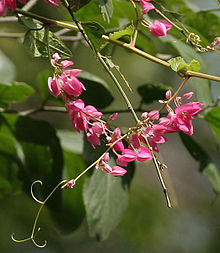
Washingtonia robusta, known by common name as the Mexican fan palm, Mexican washingtonia, or skyduster is a palm tree native to the Baja California peninsula and a small part of Sonora in northwestern Mexico. Despite its limited native distribution, W. robusta one of the most widely cultivated subtropical palms in the world. It is naturalized in Florida, California, Nevada, Arizona, New Mexico, Hawaii, Texas, parts of the Canary Islands, Spain, Portugal, France, Italy, Malta, Croatia, Montenegro, Albania, Greece, Turkey, Cyprus, Israel, Palestine, Jordan, Lebanon, Syria, Iraq, Saudi Arabia, Somalia, Bahrain, Qatar, United Arab Emirates, Oman, Yemen, Iran, Afghanistan, Egypt, Libya, Tunisia, Algeria, Morocco, and Réunion,.

Juniperus californica, the California juniper, is a species of juniper native to southwestern North America.

Layia platyglossa, commonly called coastal tidytips, is an annual wildflower of the family Asteraceae, native to western North America.

Cuscuta californica is a species of dodder known by the common names chaparral dodder and California dodder. This is an annual parasitic plant that may resemble fine strands of spaghetti or twine strewn across other species in its habitat. A mature plant of this species may fulfill all of its food and water needs from the host plant, but they rarely kill their host. It is native to western United States and Baja California in Mexico.

The Gulf of California xeric scrub is a xeric shrubland ecoregion of Mexico's Baja California Peninsula.

Ornithostaphylos is a monotypic plant genus which contains the single species Ornithostaphylos oppositifolia, commonly known as the Baja California birdbush or Baja California manzanita. A large, evergreen shrub in the heather family, this species is near-endemic to northwestern Baja California, with a small population just north of the border in San Ysidro, California. It produces a much-branched inflorescence of white, urn-shaped flowers, and has leathery leaves that appear opposite or in whorls. These characteristics separate it from its close relatives in the region, which include manzanitas (Arctostaphylos), summer holly (Comarostaphylis) and mission manzanita (Xylococcus).

Eriogonum wrightii is a species of wild buckwheat known by the common names bastardsage and Wright's buckwheat. It is native to the Southwestern United States, California, and northwest Mexico, where it grows in many plant communities, such as chaparral, in rocky habitats from mountains to deserts.

Euphorbia misera is a semi-succulent shrub in the genus Euphorbia commonly known as the cliff spurge or coast spurge. A drought-deciduous shrub, it is typically found as a gnarled, straggly plant occupying seashore bluffs, hills and deserts. Like other members of its genus, it has a milky sap, which can be found exuding out of the light gray bark when damaged. The alternately-arranged leaves are round and folded in the middle, with small hairs on them. The "flowers" can be found blooming year-round, and are colored maroon or yellow in the center with 5 white to light-yellow petal-like appendages attached outside. This species is native to the Baja California peninsula and Sonora in Mexico, and the coast of Southern California in the United States, where it is a rare species. It is threatened in some localities by the development of its coastal habitat, which tends to be prime locations for high-end residential and commercial developments.

Pachycormus is a monotypic genus of flowering plants in the cashew family commonly known as the Baja elephant tree, torote blanco, or copalquín. The single species Pachycormus discolor is endemic to the Baja California peninsula, with three varieties. This sarcocaulescent tree or shrub is characterized by its unique gnarled growth habit, skin-like exfoliating bark, and succulent nature, whose appearance has been colorfully described as "the proboscis of an elephant holding a nosegay," a "huge radish protruding from the ground," or "grotesque resemblances of the flexed limbs of a corpulent human being." This drought-deciduous species spends most of the year dormant, but following rains pinnate green leaves emerge, and in the late spring to summer the leaves yellow, fall, and give way to bright red, cream, or pink flowers that give it a striking appearance in bloom.

Boerhavia coccinea is a species of flowering plant in the four o'clock family which is known by many common names, including tar vinescarlet spiderling and red boerhavia.
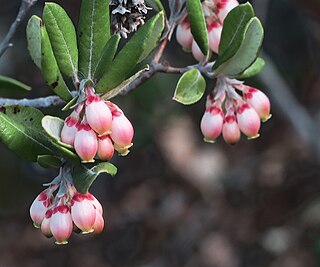
Xylococcus is a monotypic genus of flowering plants in the heather family which contains the single species Xylococcus bicolor, commonly known as the mission manzanita. It is a burl-forming, evergreen shrub with leathery leaves and smooth dark reddish bark. From December to February, white to pink urn-shaped flowers adorn the foliage, often attracting hummingbird pollinators. It is native to southern California and the Baja California Peninsula, south to the Sierra de la Giganta. There is growing concern over the future of this plant, referred to as the "queen of the elfin forest, " as it may possibly lose up to 88% of its habitat and its wild seedlings are failing to survive more than a full year.

Plantago erecta is a flowering plant in the plantain family, commonly known as the California plantain, foothill plantain, dot-seed plantain, English plantain, and dwarf plantain. Plantago erecta is a small, unassuming annual herb with needle-like leaves and translucent flowers clustered on a stalk. It grows in sandy, clay, or serpentine soils, on grassy slopes and flats or open woodland, found in Baja California, California and Oregon. Plantago erecta is a host species for the Edith's checkerspot butterfly.
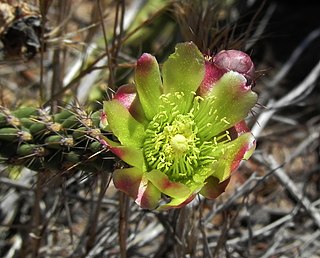
Cylindropuntia californica is a species of cholla cactus known by the common name snake cholla. It is primarily found in Baja California, Mexico and the southernmost part of California in the United States. It is characterized by a short, decumbent habit, yellow-green flowers, elongated stems, and short spines. It is mostly found in coastal sage scrub and coastal chaparral habitats, but two varieties in Baja California can be found in foothills and deserts. In California, variety californica is regarded as a rare and threatened plant, with a California Native Plant Society listing of 1B.1, in part due to its limited number of occurrences and threats from development. It formerly was considered to have a larger range due to the inclusion of Cylindropuntia bernardina within it as the variety parkeri.
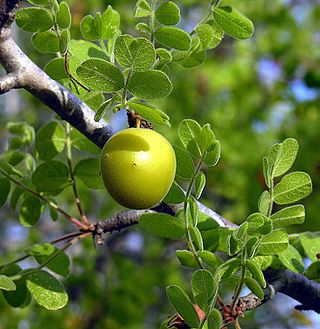
Cyrtocarpa edulis is a species of perennial sarcocaulescent tree commonly known as the Cimarrón plum or Cape wild-plum. It is in the genus Cyrtocarpa, and is endemic to Baja California Sur. This plant is characterized by fleshy stems, twisted branches and an edible drupe.
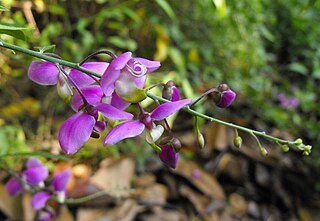
Asemeia apopetala is a species of flowering plant in the milkwort family commonly known as Brandegee milkwort or rama mora. It is a shrub or a small tree characterized by showy pink to magenta flowers that bloom from September to November or any time of year with ample rainfall. It was first described in 1889 and is endemic to Baja California Sur, Mexico. It is the type for the subgenus Apopetala of Asemeia.
Sedum alamosanum, known by the common name Alamos stonecrop, is a rare succulent plant native to the mountains of northwestern Mexico. It is characterized by white flowers and bluish-green leaves. It is found in Baja California Sur, Chihuahua, Durango, Sinaloa and Sonora.
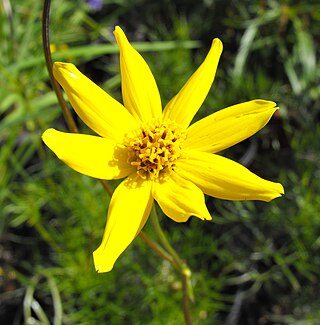
Bidens nudata is a species of perennial plant in the family Asteraceae commonly known as the Cape beggar's tick or Baja tickseed. This species is endemic to the Sierra de la Laguna and the Sierra de las Cacachilas of Baja California Sur, Mexico. It is characterized by a mounding habit, pinnate green leaves and large yellow daisy-like flowers. This species has found uses in horticulture as an ornamental, providing a drought-tolerant and durable plant for the garden.

Jacquemontia abutiloides is a species of vining plant in the bindweed family (Convolvulaceae) commonly known as the felt-leaf clustervine or felt-leaf morning-glory. A perennial characterized by wooly leaves and blue to whitish flowers, this species grows as a woody plant to shrub with vining upper stems. Flowering is from September to June. It is near-endemic to the Baja California peninsula, Mexico, concentrated mostly around the central peninsula south of the Vizcaino Desert, and found on some of the coastal islands.

Ruellia californica is a species of flowering plant in the Acanthus family commonly known as the rama parda or flor del campo. This evergreen shrub is native to the Baja California peninsula and neighboring coastal Sonora. It is characterized by showy, funnelform blue-purple flowers that bloom throughout the year. There are two subspecies, one endemic to Baja California Sur, and they primarily differ in their presence or absence of hairs on their foliage. This plant is cultivated as an ornamental, and is used to provide a colorful accent to desert and dry gardens.
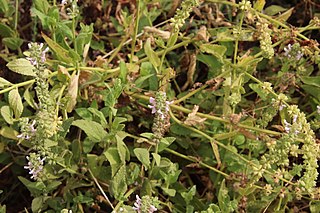
Stachys stebbinsii is a species of perennial herb in the mint family commonly known as Stebbins' hedgenettle. This plant is characterized by a musky aroma, flowers with large lower lips, and glandular hairs that densely cover the stems. S. stebbinsii is native to California and northwestern Baja California. It is usually found growing in moist places in a wide variety of habitats including disturbed areas, chaparral, coastal sage scrub and mountains.
